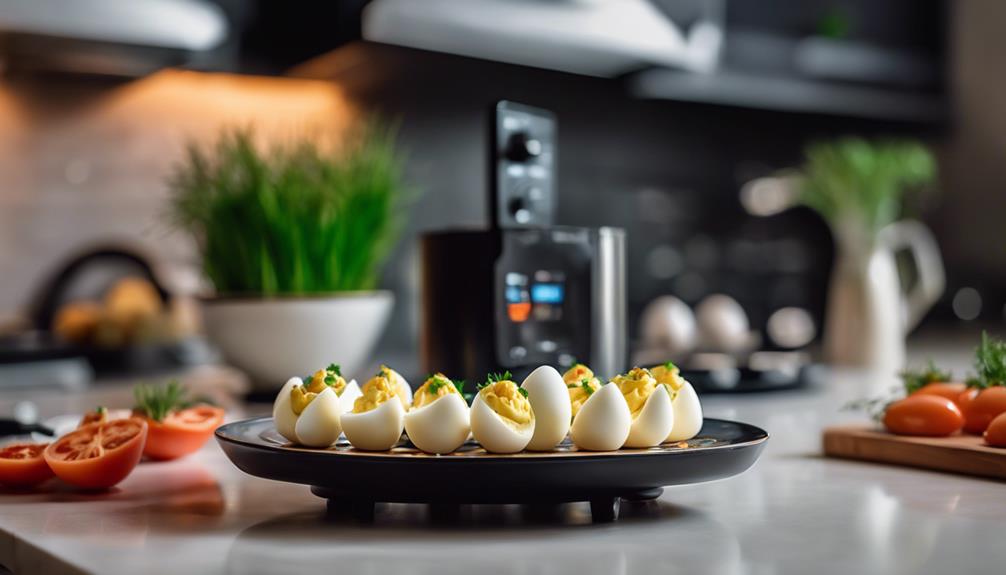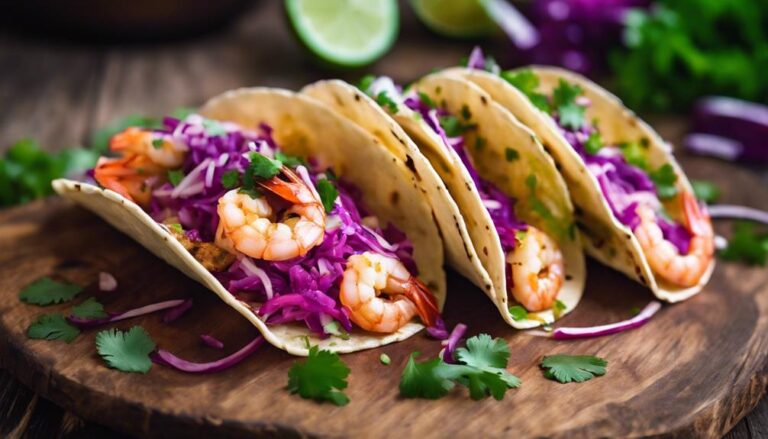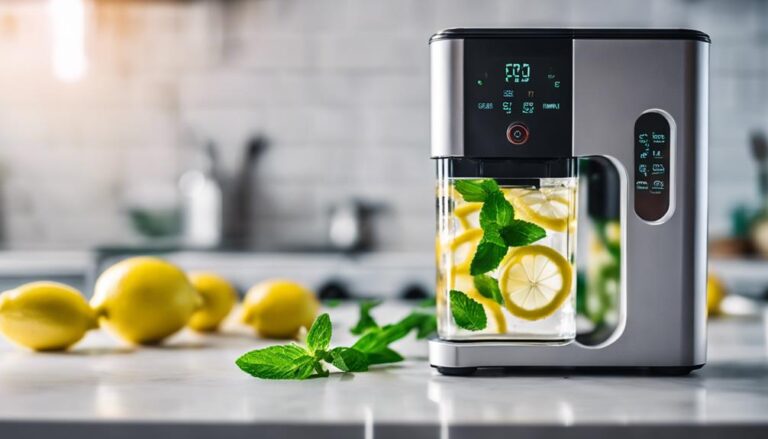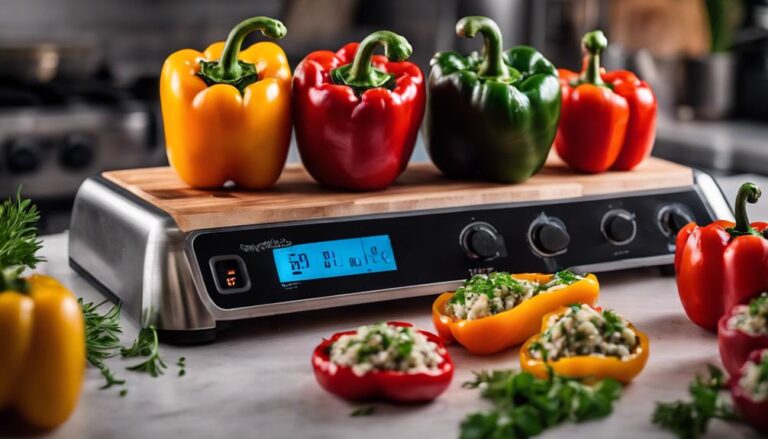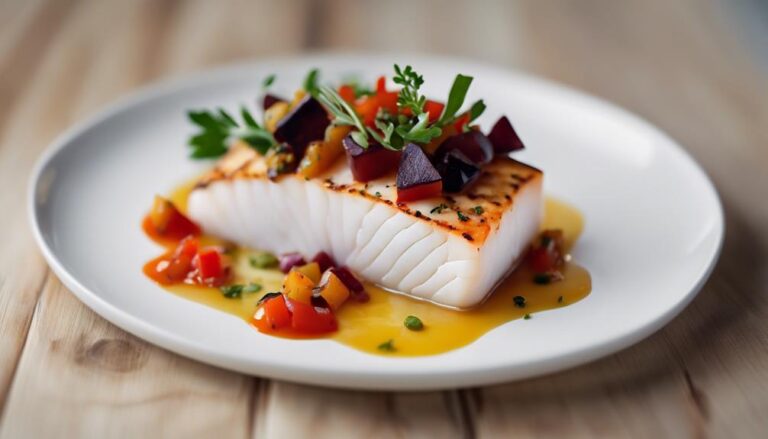One-Point Sous Vide Deviled Eggs
To craft one-point sous vide deviled eggs, start by setting your sous vide to precisely 167°F. You'll cook your eggs for one hour, ensuring creamy yolks and tender whites, foundational for luxurious fillings. After cooking, immediately plunge the eggs into an ice bath to halt the cooking, preserving their perfect texture. Peeling them becomes a breeze. Mix the yolks with mayonnaise, Dijon mustard, and a pinch of paprika for that classic zest. The precise temperature control of sous vide guarantees each egg's filling is velvety and bursting with flavor. Curious about topping variations that could elevate your eggs even further?
What You Will Learn Here
- Cook eggs sous vide at 167°F for one hour to ensure creamy yolks and tender whites.
- Immediately chill eggs in an ice bath to stop cooking and ease peeling.
- Blend yolks with mayonnaise, mustard, and spices for a rich filling.
- Refill the egg whites with the yolk mixture using a piping bag for precision.
- Garnish with paprika, herbs, or toppings like bacon for enhanced flavor and presentation.
Origins of Deviled Eggs
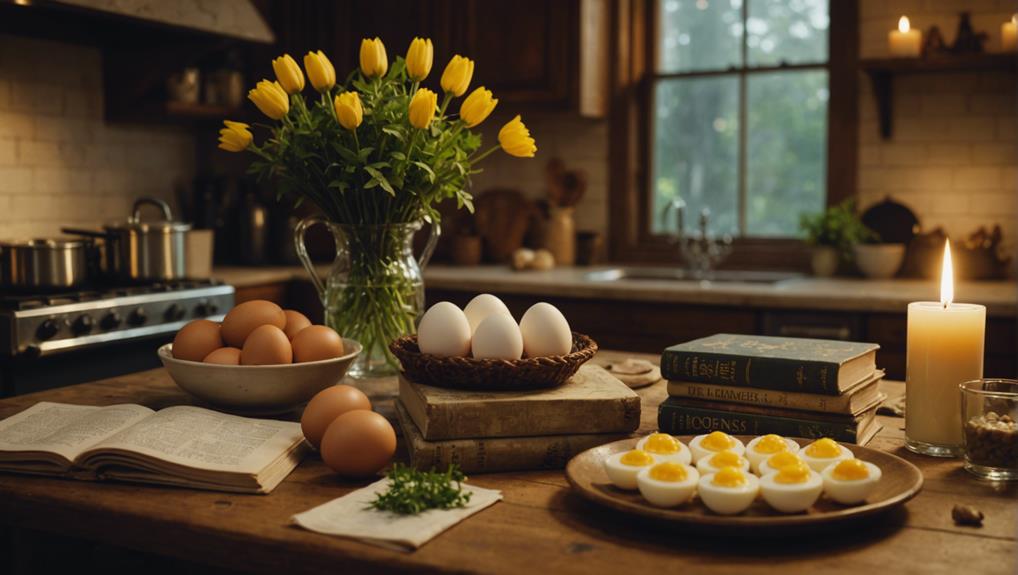
You'll find that the journey of deviled eggs begins in the bustling markets of ancient Rome, where chefs first experimented with stuffed eggs, enhancing their flavors with rich broths and sharp pepper.
As you explore global variations, you'll see how cultures adopted and adapted this dish, infusing local spices and ingredients that transformed simple eggs into culinary delights.
The key to their enduring appeal lies in the core ingredients—bold mustards, creamy mayonnaises, and the right touch of sweetness to balance the zest.
Historical Roots Explored
Tracing their luxurious origins to ancient Rome, deviled eggs have evolved from a high-end delicacy to a beloved staple at modern gatherings. You're diving into the historical roots of this dish, which began as simple boiled eggs enhanced with flavorful spices and sauces. Fast forward to your kitchen, where you're mastering Sous Vide Deviled Eggs, infusing precise flavors through controlled cooking.
Here's a detailed breakdown to assist your culinary journey:
| Era | Description | Key Ingredients |
|---|---|---|
| Ancient Rome | Starter for banquets | Pepper, herbs |
| 18th Century | Named 'deviled' | Mustard, hot sauce |
| Mid-20th USA | Popularized nationally | Mayonnaise, paprika |
| Modern Day | Party favorite | Diverse spices, mixes |
| Sous Vide | Precision cooking | Perfect temperature |
Embrace this method to serve up impeccably consistent flavors, ensuring each egg is a reflection of both ancient traditions and modern culinary innovations.
Global Variations Highlighted
As we explore the global variations of deviled eggs, it's captivating to see how each culture incorporates its unique flavors and ingredients into this classic dish.
In Mexico, the creamy texture of avocado paired with vibrant salsa gives deviled eggs a rejuvenating twist.
Heading over to Russia, the luxurious touch of caviar atop deviled eggs offers a glimpse of opulence, turning each bite into a decadent experience.
Meanwhile, Asian variations bring a bold contrast with the salty depth of soy sauce and the nutty essence of sesame oil.
These global twists not only enhance the flavor profile of traditional deviled eggs but also showcase the adaptability of sous vide eggs in embracing worldwide culinary traditions.
Key Ingredients Unveiled
Delving into the origins of deviled eggs, it's fascinating to learn that these flavorful appetizers started in ancient Rome, known then as 'gourds' and often spiced to perfection. When you prepare Sous Vide Deviled Eggs, the precision in cooking the hard boiled egg guarantees a perfect base every time.
| Ingredient | Role in Deviled Eggs | Origin |
|---|---|---|
| Hard boiled egg | Base | Ancient Rome |
| Mayonnaise | Creaminess | France |
| Mustard | Spiciness | India |
| Paprika | Color & Flavor | Americas |
This methodical approach not only preserves but elevates the ancient art of spicing eggs, making each bite a tribute to both tradition and modern culinary techniques.
Essential Deviled Eggs Components
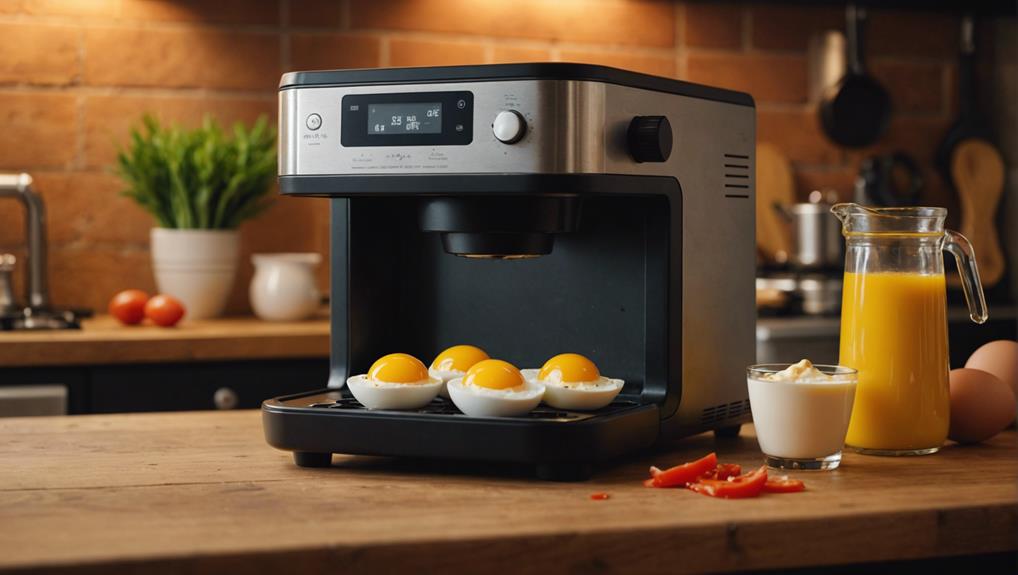
To create the quintessential deviled eggs, you'll need perfectly cooked eggs, mayonnaise, Dijon mustard, a touch of sugar, salt, and pepper, each component playing a pivotal role in achieving that classic, creamy filling. Using the sous vide method, you'll immerse your eggs in a water bath, courtesy of tools like the Anova Sous Vide Precision Cooker, which guarantees your eggs are cooked evenly throughout. This technique yields yolks that are just the right consistency for mashing and mixing with your other ingredients.
When you're ready to assemble your deviled eggs, the following ingredients are essential:
- Eggs: Choose fresh, high-quality eggs for the best texture and flavor. Sous vide cooking will make them easy to peel and perfectly tender.
- Mayonnaise: This provides the creamy base for your filling. Opt for a high-quality brand or make your own to control the flavor and richness.
- Dijon Mustard: Adds a tangy depth to balance the richness of the mayonnaise and egg yolks.
- Seasonings: A subtle touch of sugar enhances the other flavors, while salt and pepper are indispensable for seasoning your filling to perfection.
Top Deviled Egg Variations
You're in for a treat as you explore the top variations of deviled eggs that can transform your appetizer game.
Start with the Classic Paprika Deviled Eggs, where a dusting of smoked paprika perfectly complements the creamy, tangy filling.
Then, venture into the Avocado Lime Deviled Eggs for a fresher, zestier take, or kick things up a notch with the Bacon Sriracha Deviled Eggs, which combine crispy bacon and a spicy sriracha swirl.
Classic Paprika Deviled Eggs Recipe
Let's explore the recipe for Classic Paprika Deviled Eggs, a popular appetizer that blends creamy, tangy flavors with a touch of smoky paprika for a delicious kick. You'll find that the combination of Dijon mustard, mayonnaise, and a sprinkle of paprika not only enhances the flavor but also adds a vibrant color to these beloved bites.
- Boiled eggs: Carefully slice in half and remove yolks.
- Mix filling: Combine yolks with Dijon mustard and mayonnaise for a smooth, creamy texture.
- Season: Add paprika, salt, and pepper to taste, ensuring each bite has a balanced flavor.
- Garnish: Sprinkle with extra paprika for a final touch of smoky sweetness and appealing color.
Avocado Lime Deviled Eggs Recipe
While classic paprika deviled eggs offer a familiar taste, experimenting with Avocado Lime Deviled Eggs introduces a creamy texture and tangy zest that'll elevate your appetizer game. These deviled eggs blend the lush, smooth richness of avocado with the sharp, invigorating kick of lime, creating a delightful contrast that's both eye-catching and delicious.
Here's how to whip up this vibrant twist:
- Scoop out the yolks of halved boiled eggs, mixing them with mashed avocado and a sprinkle of salt.
- Squeeze in fresh lime juice for that citrusy spark.
- Fold in a touch of mayonnaise to smooth the mixture.
- Garnish with lime zest or a thin slice of avocado for an elegant finish.
Serve these at your next gathering to impress your guests with a uniquely flavorful take on deviled eggs.
Bacon Sriracha Deviled Eggs Recipe
To kick off your culinary adventure, begin by crisping up some bacon until it's perfectly crunchy to sprinkle atop your Sriracha-spiced deviled eggs. This recipe infuses the classic deviled eggs with a bold twist, perfect for those who savor smoky and spicy flavors.
Here's how you can impress your guests with these tantalizing bites:
- Cook the bacon: Make sure it's crispy for that essential crunch.
- Mix the yolks: Blend with Sriracha for a smooth, fiery filling.
- Assemble the eggs: Pipe the spicy yolk mixture back into the halved whites.
- Garnish generously: Top with bacon bits and perhaps a sprinkle of chives for a pop of color.
Serve these at your next party and watch them disappear!
Sous Vide Precision Techniques
When you set your sous vide to the ideal water temperature of 170°F, you're ensuring that each egg reaches the perfect point of doneness with precise heat. Timing your cook for exactly one hour allows the proteins in the egg to set just right, balancing firmness and creaminess without any overcooked edges.
This controlled environment lets you master the texture of the yolk, making it exceptionally smooth for a richer blend with your chosen seasonings.
Ideal Water Temperature
Setting the water temperature to exactly 167°F is essential for achieving the perfect balance of creamy yolks and tender whites in sous vide deviled eggs. By maintaining this specific heat in your water bath, you're ensuring that the eggs are cooked uniformly, avoiding the common pitfalls of traditional boiling methods. The precision of sous vide allows you to deliver consistently delightful results to guests who'll marvel at the texture and flavor.
Cooking the eggs at 167°F for one hour in the water bath is key. This duration and temperature setting guarantees that the yolks remain creamy—never chalky or overdone—while the whites stay tender yet firm, creating an ideal canvas for your flavorful fillings and garnishes.
Timing for Perfection
After mastering the ideal temperature for your sous vide deviled eggs, focusing on the timing will further enhance the texture and taste of your dish. Setting your Anova Sous Vide Precision Cooker to precisely 170°F, you'll guarantee the yolks reach their peak creamy consistency. It's essential to cook for one hour to achieve this perfection.
Once done, don't skip the chilling process; plunge your eggs into an ice bath for twenty minutes. This step is vital to stop the cooking process abruptly, locking in that delightful texture. Each minute and degree matter in this method, designed to impress your guests with every bite.
Egg Texture Control
By mastering sous vide techniques, you'll guarantee that the texture of your deviled eggs is consistently creamy and perfectly tender. Set your precision cooker to 170°F and gently place the eggs in the water.
This essential temperature is vital as it ensures the yolks remain smooth and creamy—never chalky. The gentle water bath circulates warmth evenly, avoiding the common pitfalls of overcooked, rubbery whites or those unsightly gray rings.
As the eggs cook, their yolks transform into a velvety texture, ideal for a luxurious filling. When you serve these to your guests, the uniformly cooked yolks and tender whites will reflect your care and attention to detail, enhancing both the dish and the dining experience.
Final Thoughts
You'll find that using the sous vide method for your deviled eggs not only simplifies achieving the perfect texture but also enhances the flavors in each bite. By precisely controlling the temperature at 170°F, the egg whites become tender without becoming rubbery, while the yolks achieve a creamy consistency ideal for mixing. The yolks, once removed, are blended with mayonnaise, Dijon mustard, a pinch of sugar, and seasonings, creating a rich and savory filling that complements the gentle firmness of the sous vide whites.
This meticulous process guarantees that every component of your deviled eggs is flawless, from the smoothness of the yolks to the delicate snap of the chilled, tender whites. A quick chill in an ice bath not only halts the cooking to maintain their perfect texture but also makes peeling them a breeze. You'll appreciate how each eggshell slips off, leaving behind a pristine surface ready to cradle the luscious yolk mixture.
To serve, consider the preferences of your guests for a truly bespoke experience. Garnish with a touch of crispy bacon for a smoky crunch or a spoonful of caviar for an upscale twist. Each bite delivers not just a treat for the taste buds but also a visually appealing masterpiece that invites compliments and conversation.
Frequently Asked Questions
What Is the Best Temperature for Sous Vide Eggs?
For sous vide eggs, the optimal temperature is 167°F. This precise control guarantees consistency in cooking, resulting in eggs with creamy yolks and tender whites, avoiding any texture variations that can disappoint your guests.
Can You Use a Sous Vide to Hard Boil Eggs?
Yes, you can hard boil eggs using a sous vide, ensuring uniform egg consistency with precise water circulation and cooking duration. This method offers perfectly cooked results ideal for serving at gatherings.
Can You Sous Vide Eggs at 165 Degrees?
Yes, you can sous vide eggs at 165 degrees. This temperature guarantees a custard-like yolk and firmer whites. Adjust cooking times for texture variations and always guarantee water bath safety for best results.
Do Sous Vide Eggs Peel Easier?
Yes, sous vide eggs do peel easier. The precise temperature and water immersion technique guarantee the whites separate smoothly. Freshness and cooking duration also impact peeling, making them ideal for serving at events.
Conclusion
As you savor your sous vide deviled eggs, appreciate the velvety texture achieved through precise temperature control. Each bite offers a harmonious blend of creamy yolk filling and tender whites, a tribute to the meticulous sous vide method.
Embellish with your chosen toppings for that extra pop of flavor. Remember, the key lies in patience and precision, ensuring every batch you make preserves the classic charm while introducing an unparalleled silkiness to this beloved appetizer.
